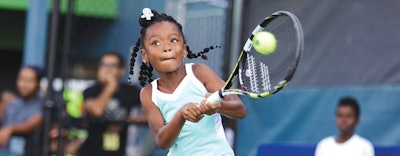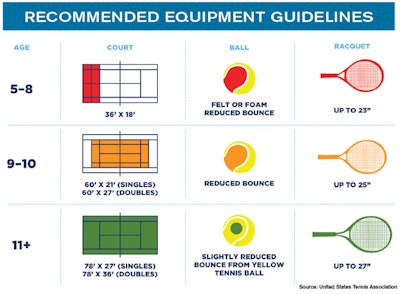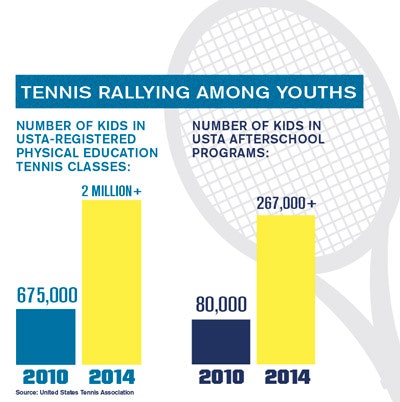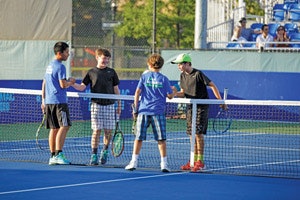
When Mike Woody recalls how he taught tennis lessons 30 years ago, he jokingly referred to those lessons as "Tennis Ball, Racket and Chase." Students would hit the tennis ball, and then go chase it down.
Tennis is a lifetime sport, attracting players of all ages. And for most of the lifetime of tennis, players of all ages played with the same-size ball on the same-size court with virtually the same-size racket.
Even during the tennis boom of the 1970s and '80s, kids were still learning to play tennis with the tools and rules used by adults. Other sports, such as baseball and soccer, have produced equipment and fields over the years better tailored to children. As a result, tennis experts say, the interest in tennis for those at a young age began to wane. The days of Connors, McEnroe, Agassi and Sampras dominating professional tennis in the United States became a fading memory, leaving youths with fewer stars to emulate. The lure of video games and other technology has kept kids away from the game, too.

Then in 2010, the United States Tennis Association made a change: It created instruction specifically for children 10 and under and introduced different sizes of tennis balls called ROGY balls (red, orange, green and yellow). The red balls have 75 percent of the compression of standard yellow balls, the orange balls have 50 percent and the green balls have 25 percent. The larger, softer tennis balls go through the air slower and bounce lower, making it easier for kids learning to play the game.
The USTA also recommended new guidelines for tennis courts, trimming down the 78-foot courts to 36 feet for ages 5 through 8 and 60 feet for ages 9 and 10. Rackets also got smaller, down to 23 inches or 25 inches, respectively, from the standard 27-inch racket.
RELATED: Kids' Tennis Change Comes with Huge Upside Potential
In 2012, the International Tennis Federation mandated that the green ball be used for all 9-year-old and 10-year-old tournaments around the world. Softer balls had already been used in Europe, particularly in Belgium and France. Regular tennis balls had not been used in 10-and-under tournaments in those countries since approximately 2007, according to a 2012 article in The Wall Street Journal. Not everybody was on board with the softer-ball requirement, however. Some parents complained their children were getting injured more frequently and believed the softer balls stunted their growth as tennis players.
"I don't think there's a solution that will satisfy everybody," famed tennis coach Nick Bollettieri, who supports the softer tennis balls, told The Wall Street Journal in 2012. "It may hinder a few right now, but I will stake my reputation that the result in the long run will pay handsome dividends."
Three years later, Bollettieri appears prophetic.

Growth Among Kids
According to the 2014 edition of the Tennis Industry Association's "The State of the Industry: Key Tennis Industry Indicators," U.S. tennis was a $5.55 billion industry in 2013, essentially flat from the previous year. Participation and sales figures relating to the 10-and-under market were showing improvement, though.
More than 2 million players from ages 6 through 12 played tennis in 2013, an increase of 4.8 percent over 2012, according to the TIA. The total number of juniors ages 13 through 17 playing tennis increased more than 14 percent in that time. New players in both age groups increased, as well: 7.5 percent among youths 6 through 12 and 35.7 percent among the 13-17 age group.
"Sustaining this momentum through industry-supported efforts to grow youth tennis is important moving forward as we look to ensuring long-term sustainability of the sport," the TIA said in its report. According to numbers from both the TIA and USTA, youth participation has been increasing steadily, particularly in the area of afterschool programming. "It was a huge change," says Scott Schultz, the USTA's managing director of junior tennis. "We really didn't have very many kids 10 and under playing because they played on the same-sized court with the same ball that they play with at the U.S. Open. It was just too darn big, too darn fast. For the masses, they just weren't able to play."
RELATED: Tennis Court Surfaces Continue to Evolve
The increase in kids 10 and under participating in tennis has correlated with interest in the game at some for-profit health clubs, including Chicago-based Midtown Athletic Clubs. Midtown has been one of the leaders in 10-and-under tennis instruction and includes the red, orange and green balls in its curriculum for beginning players of all ages.
Woody, the new national tennis director at Wichita, Kan.-based Genesis Health Clubs, agrees. "The ball has been the most instrumental change in allowing newer players to experience a rally and see how much fun it is to basically play catch," he says.
Sportime, headquartered in Kings Park, N.Y., on Long Island, has more than 160 indoor and outdoor tennis courts at its 13 tennis clubs across the state. The 13 tennis clubs are the most in the company's history, says Sportime CEO Claude Okin, one of the early adopters of 10-and-under tennis. "There was a lot of rancor and conflict in our country about whether to adopt what the USTA tried to force on everyone," Okin says. "I didn't know what those folks were thinking, to be honest. It was used very successfully for a long time in Eastern Europe and Asia. And we were just late."
 THE UNDER-13 SET According to the Tennis Industry Association, more than 2 million players from ages 6 through 12 played tennis in 2013, an increase of 4.8 percent over 2012. (Photo courtesy of Sportime/John McEnroe Tennis Academy)
THE UNDER-13 SET According to the Tennis Industry Association, more than 2 million players from ages 6 through 12 played tennis in 2013, an increase of 4.8 percent over 2012. (Photo courtesy of Sportime/John McEnroe Tennis Academy)
Promoting the Game
Sportime is promoting youth tennis through the John McEnroe Tennis Academy at the Sportime Randall's Island Tennis Center, the company's flagship location in Manhattan. The Johnny Mac Tennis Project is a charity that raises public and private funds to provide tennis academy scholarships, coaching, transportation and financial assistance to young tennis players in the greater New York City area.
"We had lost hundreds of courts in New York City over a couple of decades due to the pressure of real estate values," Okin says. "We're hoping that we can be part of bringing the demand of tennis up a little bit across New York and across the country."
While Okin is bullish on the long-range future of tennis, especially at the 10-and-under level, he is concerned about the current state of tennis overall, citing a decline in recent racket sales and the condition of tennis courts nationwide.
Leagues, tournaments and team tennis were down slightly in 2013 compared to 2012, the TIA reported. USTA league play was down slightly more than 2 percent, and the number of registered participants in USTA tournaments was down 1.7 percent. Team tennis participation also was down 2 percent.
"We have to keep juniors playing organized tennis," Okin says. "We have fewer juniors playing more, so we have sort of a professionalization of junior tennis at the most elite level, but we don't have enough strong recreational players playing enough organized events. The courts that are in schoolyards and at parks need to get reconstructed so that there are modern, safe, attractive courts to go play tennis."
RELATED: Break Point: College Tennis Tries to Rally
Although 54 percent of court contractors reported increased business in 2013 compared to 64 percent in 2012, contractors were optimistic about the current and future state of the industry, according to the TIA report, which adds that about nine in 10 court contractors who are members of the American Sports Builders Association installed 10-and-under lines on existing courts in 2013.
Also in 2013, the 10,000th court was built or lined for youth tennis in the U.S. since the launch of the youth tennis initiative. Schultz says the USTA has put down about 10 courts a day every day for the last 31⁄2 years, and that includes adding lines for 36-foot and 60-foot courts to existing 78-foot courts in addition to installing permanent 36-foot and 60-foot courts.
Perhaps tennis is on its way toward catching up with soccer, other sports, technology and the times. It all started five years ago with an initiative to attract more kids to tennis. As Schultz recalls, "It was kind of an 'aha' moment for us."
INCREASING TENNIS PARTICIPATION AT MIDTOWN ATHLETIC CLUBS
 (Photo Courtesy of Tim Wilkes)
(Photo Courtesy of Tim Wilkes)
Since 1970, when avid tennis players Alan Schwartz and his father, Kevie Schwartz, opened the first Midtown Tennis Club in Chicago, Midtown Athletic Clubs has been a leader within the for-profit health club sector in terms of tennis instruction for kids and adults. The company has eight multipurpose health clubs — four in Chicago and one each in Atlanta; Montreal, Queb.; Rochester, N.Y.; and Weston, Fla. All eight clubs offer either indoor or outdoor tennis or a combination of both. Midtown has 115 total courts, 64 outdoor and 51 indoor.
Midtown has several tennis programs, including private and group instruction, training programs, in-house leagues and tournaments. Another program is cardio tennis, which averages 1,750 participants a month, says Butch Staples, Midtown's national tennis director. In Midtown's "Tennis in No Time" program, adults new to the game use the larger and slower red, orange and green tennis balls that have been a boon to the United States Tennis Association's effort to attract more kids to the game.
According to Staples, unique tennis memberships at Midtown increased from 8,772 in fiscal year 2012 to 9,417 in fiscal year 2014. Also in fiscal year 2014, there were 369,266 Midtown member plays — or people who were participating on Midtown tennis courts — compared to 317,891 member plays in fiscal year 2012.
"At Midtown Athletic Clubs, tennis is a critical element in creating a resort-style environment," says Steve Schwartz, CEO of Midtown Athletic Clubs and the son and grandson of the company's founders. "That's a feeling you don't get in a health club without tennis. When you are sitting having a snack after exercising — looking out over an expansive, landscaped outdoor tennis environment — it's a different aesthetic than sitting in a juice bar in a gym.
"We look at tennis as an actively managed part of the business," Schwartz adds. "We want our tennis facilities to be the best in class."
This article originally appeared in the October 2015 issue of Athletic Business with the title "On the Ball"
































